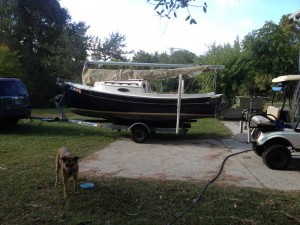
Libby wanted to play frisbee and was very frustrated that I was paying so much attention to that darn boat again!
Preparing a Sun Cat for a class racing event is grueling work. In addition to checking for wasps, I tightened the shrouds a bit, since they have been looking a bit loose for the past couple of years. Such is the intensity of Sun Cat Class competition.
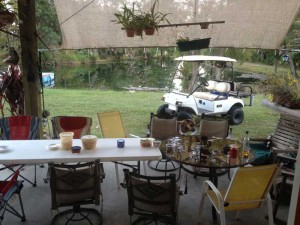
Putting out snacks and Wish Key on the porch prior to our skippers’ meeting was another activity that did not involve enough frisbee playing for Libby’s taste. For those who can’t translate doggy looks, that one means, “Why would you even have a big, stinky, frisbee-obsessed dog if not to play with her?”

At the skippers’ meeting, previous National Champion Scott agreed to sail with Nationals newbie Chris aboard his green 2003 Sun Cat, Second Wind. When I walked out into the driveway Saturday morning, I thought we might see the big sail that Scott used in his past victories.
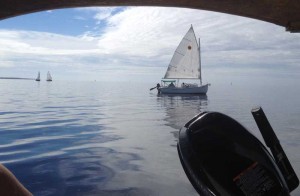
There was not a sail big enough for the winds we encountered as the Sun Cat Class gathered for racing. By tradition, we have wind for the Sun Cat Nationals only every other year, and we’re pretty big on sailing traditions in the Sun Cat Class, so we were drifting around on the glassy harbor.
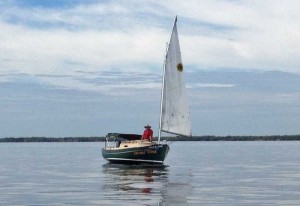
Scott was using his weight to try to ease Second Wind along in the light winds. Being a lake sailor, he knows that getting the stern out of the water and inducing a bit of heel will make these boats move at least a little bit, when otherwise the boat would just sit.
It was not working. The best tricks don’t work if there is no wind. I was starting to worry that we would not get to race at all. I expected a mid-day calm and was hoping we could race before it arrived. It arrived early and we would have to wait for it to end, if it did.
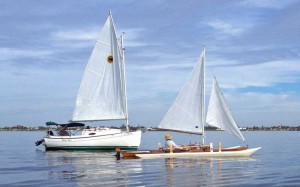
While we were drifting about, a friend of Jack’s showed up in his homebuilt kayak-trimaran sailing rig. It looks like it might sail pretty fast if we had wind, but even this boat was barely moving.
In previous no-wind years, we had Sun Cats drifting around the race course, sometimes doing unintended 360 degree turns, but we at least managed to complete one race. It looked like that tradition might be broken.
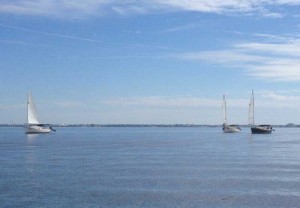
Meanwhile, back in Alligator Bay, I could see the race committee coming out the channel with a fleet of Sunfish attempting to follow. They had about the same wind we did and were lucky the tide was going out. My phone rang and it was Dennis, our race committee head. I was pretty sure I knew what was coming.
He asked if we could race in Alligator Bay, as the Sunfish were having trouble making it out into the harbor. I told him that was fine if he could keep us in 4.5 feet of water. With low tide approaching, we both knew this was impossible. I could almost see the grimace over the phone. He said they’d be out as soon as possible. A little discussion between the head of a racing class and the race committee is another good sailing tradition.
Soon, a tiny bit of wind came up and I started leading the Sun Cat Class north into the mouth of Alligator Bay, trying to make it as easy as possible for the Sunfish to reach the racing area. I have hit all of the shallow water in the area enough times to know how close we could race.
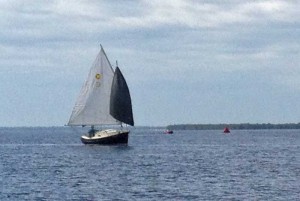
In the distance, we could see Dale approaching in Zeke, flying his spinnaker. Adding sails or changing underwater foils is completely legal under the Sun Cat Class racing rule, which says only that you must sail a hull that is arguably a Sun Cat hull. He had a canvas sock and some way of launching it solo, so I was hoping to see it during the races, but it did not come out.
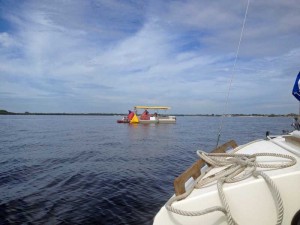
The race committee anchored in the mouth of Alligator Bay and started sending out marks using the inflatable safety boat. I thought about putting away our bow line before taking this picture, but decided leaving it there was more in the spirit of Sun Cat Class racing.
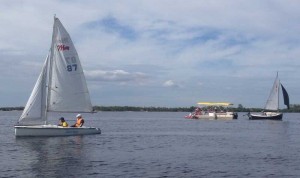
The first of the Portsmouth racing fleet to arrive at the course was this Martin 16, being sailed by two sailors whose wheelchairs are back on the dock. Dennis Peck and the Charlotte Harbor Community Sailing Center work hard to make this kind of thing happen as often as possible. On the water, their movement is restricted only by the wind and their skill, just like any other sailor.
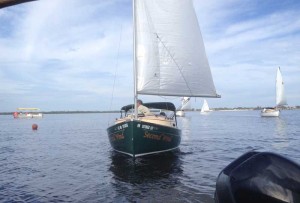
The race course was set and the Sun Cat Class was milling around in the area of the starting line. In the background are Jack in About Time and a Precision 185 that is racing in the Portsmouth fleet, with Larry in Indy Anna off to the right. I noted that Scott was at the helm of Second Wind, a situation that might bear watching…

Oh NO! Attempted McLemore! I knew he should be watched! I thought that with the absence of any Horizon Cat Class boats, outboards dangling off transoms would be safe this year!
(Sorry, CM, had to do it. Get well soon! Missed you!)
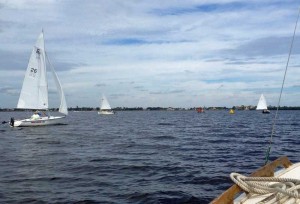
We got off to a pretty good start, by Sun Cat Class standards, in Wily Conch, but Dale passed us in Zeek and kept his lead the rest of the race. I took the picture at right just after we rounded the windward mark. Zeek is approaching the finish line. Meanwhile, Indy Anna, having a tough time, has just rounded the leeward mark. The Class was so spread out that the race committee wound up calling Indy Anna in and scoring them DNF in the first race. This may have had something to do with Larry’s decision to purchase Scott’s big sail.
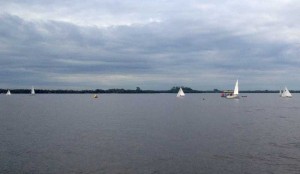
At the start of the second race, the current from the incoming tide had started to pick up and I realized that this would mean the left side of the race course would be heavily favored, as the current is weaker out there. None of our other Sun Cat Class racers knew how much the current would affect us in such light winds, nor where it flowed the strongest. As a result, we quickly completed the race in Wily Conch then sailed around the starting area for quite a while as the rest of the fleet struggled.
Through dogged determination, Jack managed to get around the right side of the course in About Time despite the opposing current and took second place in race two. I took the picture at left in part because I could not believe he made it!
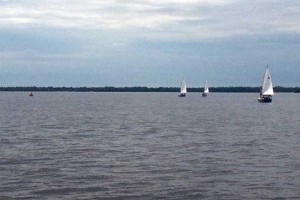
The rest of the Sun Cat Class was still out on the course with the wind slowly dying as the current increased in speed. I sailed over to the race committee and asked whether they had a calendar, since an ordinary stopwatch was looking insufficient to time this race.
That got a good laugh out of committee and spectators and signaled my agreement as head of the Sun Cat Class that this race was over and we should find a way to end it gracefully. Dennis promptly pulled anchor, shortened the race course, and finished all the boats. Great job, and just what needed to happen at that point! I had wanted to sail at least three races, but it was just not possible.
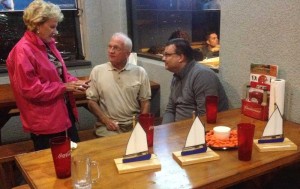
Dale brought us hand-made stained glass Sun Cat racing trophies for the awards dinner. They look great and I love having one, but I hope they don’t destroy the spirit of Sun Cat Class racing. Fancy trophies are not the goal, fun is! For my part, I have to say that the Sun Cat Nationals once again succeeded brilliantly in the primary goal: amusing me. I hope everyone else had as much fun!
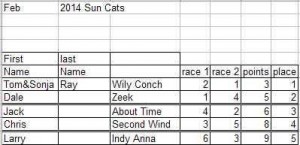
At right are the official Sun Cat National Championship results for 2014. Once again, we have proven that the blue ones are fastest. Or something.
With three out of five National Championships going to the mostly unmodified Wily Conch, perhaps we have proven that standard factory boats are fastest.
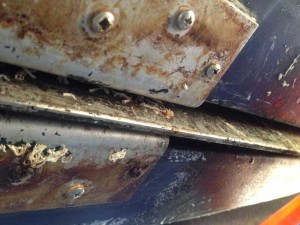
OK, OK, those are silly theories and it’s time for me to admit the truth. The previous owner of Wily Conch carefully cultivated a speed reef composed of tubeworms and barnacles on the centerboard. Although some of it has since been worn off in grounding incidents, I have maintained it since buying the boat in 2009. For those wishing to push the competitive edge on their Sun Cats, I have included the helpful photo at left.
Leave a Reply
You must be logged in to post a comment.